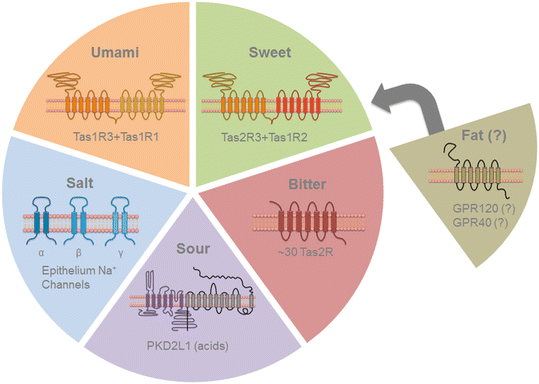Historical Background
Mammals are able to detect and interpret five main taste qualities: sweet, salty, sour, umami, and bitter, with a possible sixth modality (fat) having been recently identified (Liu et al. 2011). Like all sensory systems, those involved in the detection of taste are thought to have evolved as a tool to enhance survival in new environments and to increase fitness (Fig. 1).
The five taste modalities and their receptors. Umami, sweet, and bitter taste receptors are members of the GPCR family, while salt taste perception is mediated by epithelial sodium channels and sour taste perception is mediated by acidic compounds acting at the PKD2L1 receptor. The sixth proposed taste modality, fat, is pictured with the GPR120 receptor, which has been implicated in its function along with GPR40
References
Adler E, Hoon MA, Mueller KL, Chandrashekar J, Ryba NJ, Zuker CS. A novel family of mammalian taste receptors. Cell. 2000;100:693–702.
Andres-Barquin PJ, Conte C. Molecular basis of bitter taste: the T2R family of G protein-coupled receptors. Cell Biochem Biophys. 2004;41:99–112. doi:10.1385/CBB:41:1:099.
Avau B, Depoortere I. The bitter truth about bitter taste receptors: beyond sensing bitter in the oral cavity. Acta Physiol (Oxf). 2016;216:407–20. doi:10.1111/apha.12621.
Avau B, Rotondo A, Thijs T, Andrews CN, Janssen P, Tack J, et al. Targeting extra-oral bitter taste receptors modulates gastrointestinal motility with effects on satiation. Sci Rep. 2015;5:15985. doi:10.1038/srep15985.
Bachmanov AA, Beauchamp GK. Taste receptor genes. Annu Rev Nutr. 2007;27:389–414. doi:10.1146/annurev.nutr.26.061505.111329.
Bachmanov AA, Bosak NP, Lin C, Matsumoto I, Ohmoto M, Reed DR, et al. Genetics of taste receptors. Curr Pharm Des. 2014;20:2669–83.
Behrens M, Meyerhof W. Mammalian bitter taste perception. Results Probl Cell Differ. 2009;47:203–20. doi:10.1007/400_2008_5.
Chandrashekar J, Mueller KL, Hoon MA, Adler E, Feng L, Guo W, et al. T2Rs function as bitter taste receptors. Cell. 2000;100:703–11.
Deshpande DA, Wang WC, McIlmoyle EL, Robinett KS, Schillinger RM, An SS, et al. Bitter taste receptors on airway smooth muscle bronchodilate by localized calcium signaling and reverse obstruction. Nat Med. 2010;16:1299–304. doi:10.1038/nm.2237.
Di Pizio A, Levit A, Slutzki M, Behrens M, Karaman R, Niv MY. Comparing Class A GPCRs to bitter taste receptors: Structural motifs, ligand interactions and agonist-to-antagonist ratios. Methods Cell Biol. 2016;132:401–27. doi:10.1016/bs.mcb.2015.10.005.
Dong D, Jones G, Zhang S. Dynamic evolution of bitter taste receptor genes in vertebrates. BMC Evol Biol. 2009;9:12. doi:10.1186/1471-2148-9-12.
Feng P, Zheng J, Rossiter SJ, Wang D, Zhao H. Massive losses of taste receptor genes in toothed and baleen whales. Genome Biol Evol. 2014;6:1254–65. doi:10.1093/gbe/evu095.
Finger TE, Böttger B, Hansen A, Anderson KT, Alimohammadi H, Silver WL. Solitary chemoreceptor cells in the nasal cavity serve as sentinels of respiration. Proc Natl Acad Sci U S A. 2003;100:8981–6. doi:10.1073/pnas.1531172100.
Gaida MM, Mayer C, Dapunt U, Stegmaier S, Schirmacher P, Wabnitz GH, et al. Expression of the bitter receptor T2R38 in pancreatic cancer: localization in lipid droplets and activation by a bacteria-derived quorum-sensing molecule. Oncotarget. 2016;7(11):12623–32. doi:10.18632/oncotarget.7206.
Lee RJ, Kofonow JM, Rosen PL, Siebert AP, Chen B, Doghramji L, et al. Bitter and sweet taste receptors regulate human upper respiratory innate immunity. J Clin Invest. 2014;124:1393–405. doi:10.1172/JCI72094.
Liu P, Shah BP, Croasdell S, Gilbertson TA. Transient receptor potential channel type M5 is essential for fat taste. J Neurosci. 2011;31:8634–42. doi:10.1523/JNEUROSCI.6273-10.2011.
Picone B, Hesse U, Panji S, Van Heusden P, Jonas M, Christoffels A. Taste and odorant receptors of the coelacanth–a gene repertoire in transition. J Exp Zool B Mol Dev Evol. 2014;322:403–14. doi:10.1002/jez.b.22531.
Shaik FA, Singh N, Arakawa M, Duan K, Bhullar RP, Chelikani P. Bitter taste receptors: Extraoral roles in pathophysiology. Int J Biochem Cell Biol. 2016; doi:10.1016/j.biocel.2016.03.011.
Singh N, Chakraborty R, Bhullar RP, Chelikani P. Differential expression of bitter taste receptors in non-cancerous breast epithelial and breast cancer cells. Biochem Biophys Res Commun. 2014;446:499–503. doi:10.1016/j.bbrc.2014.02.140.
Wong GT, Ruiz-Avila L, Margolskee RF. Directing gene expression to gustducin-positive taste receptor cells. J Neurosci. 1999;19:5802–9.
Author information
Authors and Affiliations
Corresponding author
Editor information
Editors and Affiliations
Rights and permissions
Copyright information
© 2016 Springer Science+Business Media LLC
About this entry
Cite this entry
Martin, L.T.P., Dupré, D.J. (2016). Bitter Taste Receptors. In: Choi, S. (eds) Encyclopedia of Signaling Molecules. Springer, New York, NY. https://doi.org/10.1007/978-1-4614-6438-9_101498-1
Download citation
DOI: https://doi.org/10.1007/978-1-4614-6438-9_101498-1
Received:
Accepted:
Published:
Publisher Name: Springer, New York, NY
Online ISBN: 978-1-4614-6438-9
eBook Packages: Springer Reference Biomedicine and Life SciencesReference Module Biomedical and Life Sciences


